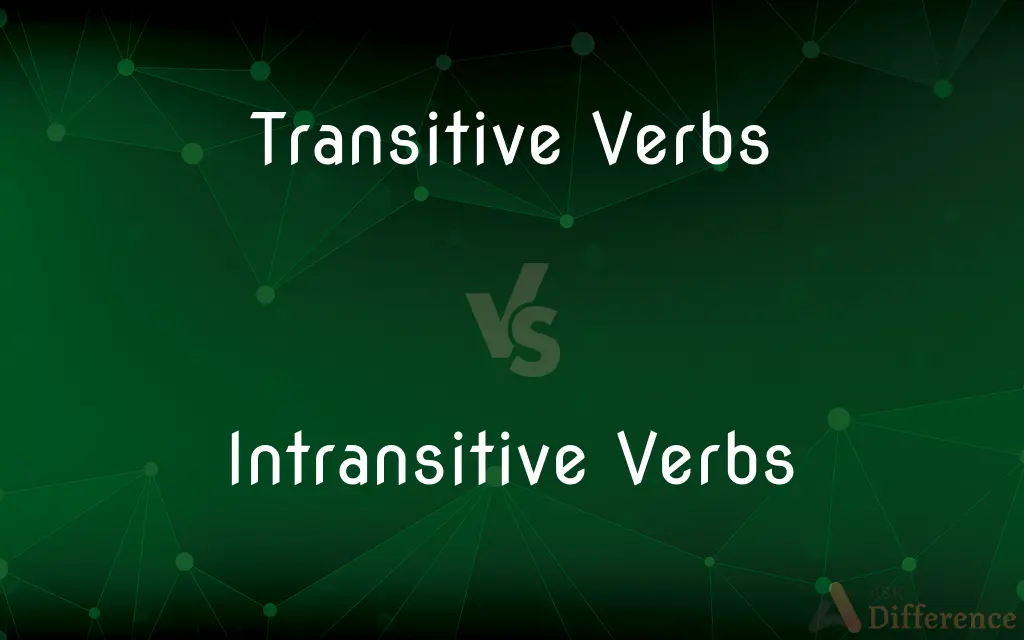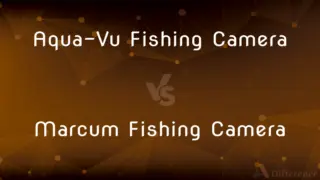Transitive Verbs vs. Intransitive Verbs — What's the Difference?
Edited by Tayyaba Rehman — By Fiza Rafique — Published on December 5, 2023
Transitive Verbs require a direct object to complete their meaning, while Intransitive Verbs do not take a direct object.

Difference Between Transitive Verbs and Intransitive Verbs
Table of Contents
ADVERTISEMENT
Key Differences
In the realm of grammar, Transitive Verbs and Intransitive Verbs are classifications based on how they function in a sentence. Transitive Verbs are those that need a direct object to make sense. For instance, in the sentence "She reads a book," "reads" is the transitive verb and "book" is the object it requires. Without the object, the action lacks clarity.
In contrast, Intransitive Verbs stand alone without the need for a direct object to complete their meaning. An example would be "He runs." Here, "runs" is the intransitive verb, and it doesn't need an object to convey its action. The sentence is complete and meaningful in itself.
While Transitive Verbs demonstrate action that transfers to an object, Intransitive Verbs depict action that does not transfer. In the sentence "She baked a cake," "baked" is a transitive verb because the action is done to the cake. Conversely, in "Birds sing," "sing" is intransitive, as the action doesn't transfer to an object.
It's essential to understand that some verbs can be both transitive and intransitive based on their usage in different contexts. For example, "eat" is transitive in "He eats pizza" and intransitive in "He eats quickly." It's the presence or absence of a direct object that distinguishes Transitive Verbs from Intransitive Verbs.
In teaching and learning English, discerning between Transitive Verbs and Intransitive Verbs is crucial. It helps in sentence construction and ensures clarity of expression. While transitive verbs help provide detail by specifying what the action is directed towards, intransitive verbs emphasize the action itself without diversion.
ADVERTISEMENT
Comparison Chart
Direct Object Requirement
Require a direct object to complete their meaning.
Do not need a direct object to be complete.
Action Direction
Action transfers to an object.
Action does not transfer to an object.
Example
She reads a book. (action on book)
He sleeps. (no object for action)
Sentence Completeness Without Object
Incomplete without a direct object.
Complete even without a direct object.
Dual Functionality
Some can also act as intransitive based on context.
Some can also act as transitive depending on context.
Compare with Definitions
Transitive Verbs
Transitive Verbs are incomplete without specifying what or whom the action is affecting.
She gave a gift.
Intransitive Verbs
Intransitive Verbs create complete sentences without specifying an object.
He runs.
Transitive Verbs
Transitive Verbs need a direct object to convey a full meaning.
She plays the piano.
Intransitive Verbs
Intransitive Verbs focus on the action itself, not what receives it.
She sings.
Transitive Verbs
Transitive Verbs can sometimes function as intransitive.
Birds fly the skies.
Intransitive Verbs
Intransitive Verbs depict actions that don't transfer to an object.
They laughed.
Transitive Verbs
Transitive Verbs showcase action that impacts an object.
He broke the vase.
Intransitive Verbs
Intransitive Verbs stand alone without a direct object.
She smiles.
Transitive Verbs
Transitive Verbs allow sentences to provide detailed information.
He wrote a letter.
Intransitive Verbs
Intransitive Verbs can sometimes function as transitive based on context.
Birds fly.
Common Curiosities
What are Transitive Verbs?
Transitive Verbs require a direct object to complete their meaning.
How do Intransitive Verbs function in a sentence?
Intransitive Verbs do not take a direct object and stand alone to convey their meaning.
Do Transitive Verbs always require a direct object?
Yes, Transitive Verbs always need a direct object to convey a full meaning.
Which verb type, Transitive or Intransitive, gives more detailed information?
Transitive Verbs, as they specify the object being affected by the action.
How can I identify Transitive Verbs in a sentence?
If a verb has a direct object receiving the action, it's a transitive verb.
What happens if I use a Transitive Verb without an object?
The sentence might feel incomplete or might not convey a clear meaning.
Can a verb be both transitive and intransitive?
Yes, some verbs can function as both transitive and intransitive based on their context in a sentence.
Why is it essential to differentiate between Transitive Verbs and Intransitive Verbs?
Differentiating helps in correct sentence construction and clarity of expression in English.
Can I use a direct object with an Intransitive Verb?
Typically, no. Intransitive Verbs are complete without a direct object.
Why is understanding Transitive and Intransitive Verbs important for learners?
It aids in constructing grammatically correct and clear sentences in English.
Are there verbs that are always intransitive?
Some verbs are predominantly intransitive, like "arrive" or "sleep," but context is crucial.
Between Transitive and Intransitive Verbs, which one is more common in English?
Both are common, but the context and sentence construction will dictate which one to use.
Can an Intransitive Verb take an object?
Typically, Intransitive Verbs do not take a direct object, but they might have other complements or adverbials.
Can the presence of an object always determine if a verb is transitive?
Not always, as some verbs can be both transitive and intransitive based on context.
Do all languages differentiate between Transitive Verbs and Intransitive Verbs?
Many languages do, but the rules and distinctions might vary from one language to another.
Share Your Discovery

Previous Comparison
Heavy Cream vs. Buttermilk
Next Comparison
Aqua-Vu Fishing Camera vs. Marcum Fishing CameraAuthor Spotlight
Written by
Fiza RafiqueFiza Rafique is a skilled content writer at AskDifference.com, where she meticulously refines and enhances written pieces. Drawing from her vast editorial expertise, Fiza ensures clarity, accuracy, and precision in every article. Passionate about language, she continually seeks to elevate the quality of content for readers worldwide.
Edited by
Tayyaba RehmanTayyaba Rehman is a distinguished writer, currently serving as a primary contributor to askdifference.com. As a researcher in semantics and etymology, Tayyaba's passion for the complexity of languages and their distinctions has found a perfect home on the platform. Tayyaba delves into the intricacies of language, distinguishing between commonly confused words and phrases, thereby providing clarity for readers worldwide.











































